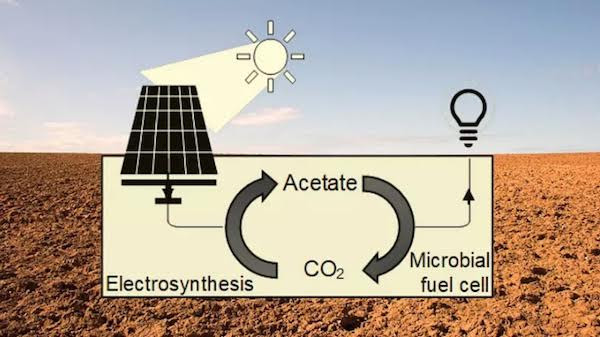Researchers at Cardiff University have found an innovative solution to overcome one of renewable energy’s biggest hurdles, storing the captured electricity when the sun does not shine and the wind does not blow. A solution they say that has lain beneath our feet all along and could solve the problem of smoothing out the peaks and troughs in energy generation.
Heading up the team is Dr. Michael Harbottle, who says he first got the idea from reading about a concrete battery that used a chemical process and wondered whether a biochemical process might not have more to offer. I’m told the plan is to send electricity from solar panels to buried electrodes, thereby stimulating certain bacteria in the soil. According to Harbottle, if you make energy available to microorganisms, they’ll use it in some way to survive, just like providing food, if you provide electrical energy, there are organisms who can use that to perform electrosynthesis, where they synthesize carbon-based molecules from carbon dioxide.
Harbottle explained that it’s a bit like photosynthesis, whereby plants take in CO2 and transform it in their cells but it all happens below ground instead. When the CO2 and electrical power come together, microbes get to work using the energy to reduce the carbon dioxide and make a more complex molecule called acetate. He describes the acetate as being the same sort of molecule found in vinegar minus the acid, which will act as a chemical store of energy. Then, when needed, another circuit, known as a microbial fuel cell, will activate a different set of bacteria to break down the acetate.
Researchers are excited about all the positives of using microbes to do the job but mostly because they will eliminate the need for resource-limited or hazardous chemicals like lithium that are used in other battery technologies. It’s worth noting that at the moment, microbial fuel cells can only supply low voltages and their use will be restricted to relatively low power systems but the long-term plans include having these batteries set up below solar panels and tied together in order to scale up by joining hundreds of cells together to produce a far higher voltage.
As Harbottle’s team pursues the soil battery solution they will also be looking into carbon storage. The premise is that if you’re converting CO2 to a carbon-based molecule, the molecules that don’t get consumed by the microbial fuel cell may end up being in the ground for some time, effectively creating a way of pumping carbon dioxide into the ground. These along with many other speculative projects in emerging technologies are all racing to try and move the ball forward in regards to energy storage. It’s certainly interesting to think about all of the new upcoming opportunities in “energy storage”! (Source: euronewsgreen; cardiff.ac.uk, biz.crast.net, avionicsforum.com)







